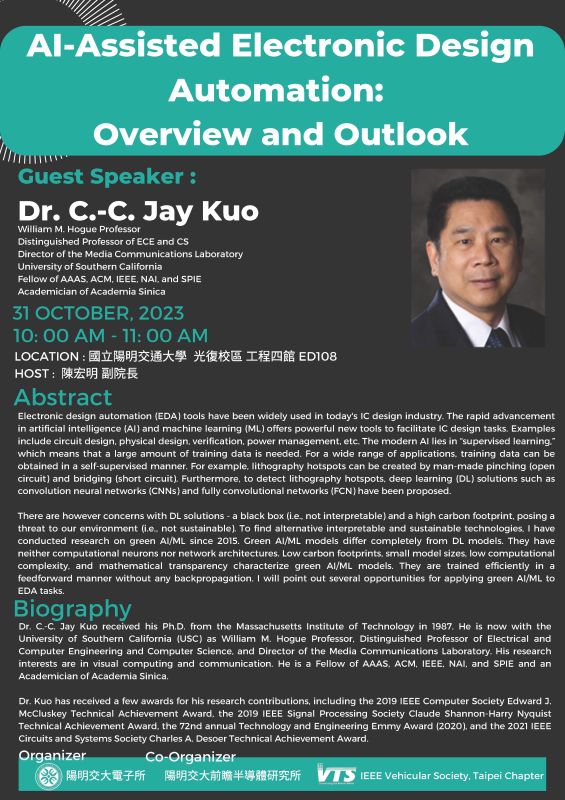演講/活動
2023-10-20 14:01:56【Talk】Dr. C.-C. Jay Kuo—AI-Assisted Electronic Design Automation:Overview and Outlook
Welcome all to come !!!
【Talk】Dr. C.-C. Jay Kuo—AI-Assisted Electronic Design Automation:Overview and Outlook
Welcome all to come !!!
Time:31 OCTOBER, 2023 10: 00 AM - 11: 00 AM
LOCATION : ED108, Engineering Building 4, NYCU 國⽴陽明交通⼤學 光復校區 ⼯程四館 ED108
Speaker:
Dr. C.-C. Jay Kuo
William M. Hogue Professor
Distinguished Professor of ECE and CS
Director of the Media Communications Laboratory
University of Southern California
Fellow of AAAS, ACM, IEEE, NAI, and SPIE
Academician of Academia Sinica
Time:31 OCTOBER, 2023 10: 00 AM - 11: 00 AM
LOCATION : 國⽴陽明交通⼤學 光復校區 ⼯程四館 ED108
HOST : 陳宏明 副院⻑
Abstract
Electronic design automation (EDA) tools have been widely used in today's IC design industry. The rapid advancement
in artificial intelligence (AI) and machine learning (ML) offers powerful new tools to facilitate IC design tasks. Examples include circuit design, physical design, verification, power management, etc. The modern AI lies in “supervised learning,” which means that a large amount of training data is needed. For a wide range of applications, training data can be obtained in a self-supervised manner. For example, lithography hotspots can be created by man-made pinching (open circuit) and bridging (short circuit). Furthermore, to detect lithography hotspots, deep learning (DL) solutions such as convolution neural networks (CNNs) and fully convolutional networks (FCN) have been proposed.
There are however concerns with DL solutions - a black box (i.e., not interpretable) and a high carbon footprint, posing a threat to our environment (i.e., not sustainable). To find alternative interpretable and sustainable technologies, I have conducted research on green AI/ML since 2015. Green AI/ML models differ completely from DL models. They have neither computational neurons nor network architectures. Low carbon footprints, small model sizes, low computational complexity, and mathematical transparency characterize green AI/ML models. They are trained efficiently in a feedforward manner without any backpropagation. I will point out several opportunities for applying green AI/ML to EDA tasks.
Biography
Dr. C.-C. Jay Kuo received his Ph.D. from the Massachusetts Institute of Technology in 1987. He is now with the
University of Southern California (USC) as William M. Hogue Professor, Distinguished Professor of Electrical and Computer Engineering and Computer Science, and Director of the Media Communications Laboratory. His research interests are in visual computing and communication. He is a Fellow of AAAS, ACM, IEEE, NAI, and SPIE and an Academician of Academia Sinica.
Dr. Kuo has received a few awards for his research contributions, including the 2019 IEEE Computer Society Edward J. McCluskey Technical Achievement Award, the 2019 IEEE Signal Processing Society Claude Shannon-Harry Nyquist Technical Achievement Award, the 72nd annual Technology and Engineering Emmy Award (2020), and the 2021 IEEE Circuits and Systems Society Charles A. Desoer Technical Achievement Award.
Welcome all to come !!!
Time:31 OCTOBER, 2023 10: 00 AM - 11: 00 AM
LOCATION : ED108, Engineering Building 4, NYCU 國⽴陽明交通⼤學 光復校區 ⼯程四館 ED108
Speaker:
Dr. C.-C. Jay Kuo
William M. Hogue Professor
Distinguished Professor of ECE and CS
Director of the Media Communications Laboratory
University of Southern California
Fellow of AAAS, ACM, IEEE, NAI, and SPIE
Academician of Academia Sinica
Time:31 OCTOBER, 2023 10: 00 AM - 11: 00 AM
LOCATION : 國⽴陽明交通⼤學 光復校區 ⼯程四館 ED108
HOST : 陳宏明 副院⻑
Abstract
Electronic design automation (EDA) tools have been widely used in today's IC design industry. The rapid advancement
in artificial intelligence (AI) and machine learning (ML) offers powerful new tools to facilitate IC design tasks. Examples include circuit design, physical design, verification, power management, etc. The modern AI lies in “supervised learning,” which means that a large amount of training data is needed. For a wide range of applications, training data can be obtained in a self-supervised manner. For example, lithography hotspots can be created by man-made pinching (open circuit) and bridging (short circuit). Furthermore, to detect lithography hotspots, deep learning (DL) solutions such as convolution neural networks (CNNs) and fully convolutional networks (FCN) have been proposed.
There are however concerns with DL solutions - a black box (i.e., not interpretable) and a high carbon footprint, posing a threat to our environment (i.e., not sustainable). To find alternative interpretable and sustainable technologies, I have conducted research on green AI/ML since 2015. Green AI/ML models differ completely from DL models. They have neither computational neurons nor network architectures. Low carbon footprints, small model sizes, low computational complexity, and mathematical transparency characterize green AI/ML models. They are trained efficiently in a feedforward manner without any backpropagation. I will point out several opportunities for applying green AI/ML to EDA tasks.
Biography
Dr. C.-C. Jay Kuo received his Ph.D. from the Massachusetts Institute of Technology in 1987. He is now with the
University of Southern California (USC) as William M. Hogue Professor, Distinguished Professor of Electrical and Computer Engineering and Computer Science, and Director of the Media Communications Laboratory. His research interests are in visual computing and communication. He is a Fellow of AAAS, ACM, IEEE, NAI, and SPIE and an Academician of Academia Sinica.
Dr. Kuo has received a few awards for his research contributions, including the 2019 IEEE Computer Society Edward J. McCluskey Technical Achievement Award, the 2019 IEEE Signal Processing Society Claude Shannon-Harry Nyquist Technical Achievement Award, the 72nd annual Technology and Engineering Emmy Award (2020), and the 2021 IEEE Circuits and Systems Society Charles A. Desoer Technical Achievement Award.


